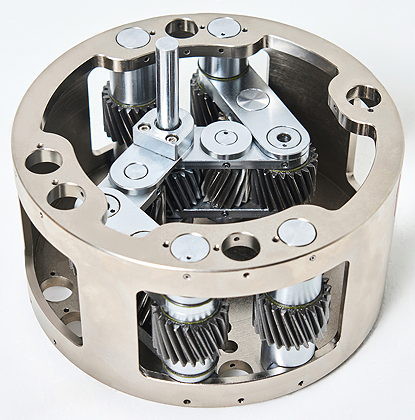- Home » News » Technology News
‘Paradigm-shifting’ in-wheel drive could revamp EV designs

The Korean automotive giants Kia and Hyundai have announced an in-wheel drive technology that they predict will revolutionise the design of future transport systems. The Universal Wheel Drive System – or Uni Wheel – moves reduction gears inside a vehicle’s wheel hub, and locates a compact motor close to the wheel, reducing the length of the drive shafts and freeing up space within the vehicle.
The technology could potentially be applied to all forms of motorised transport from passenger cars to mobile robots. It is claimed to deliver excellent efficiency, power and durability without affecting ride comfort, and could result in longer battery ranges, increased passenger and storage space, and large flat floors in commercial vehicles.
The wheel uses a special planetary gear configuration consisting of a sun gear in the centre, four pinion gears on each side, and a ring gear surrounding this arrangement. Power from the motor is transmitted to the sun gear, which in turn engages the pinion gears to rotate the ring gear. This is connected to the wheel to drive the vehicle.
The pinion gears are connected to each other to form two linkages. This multi-link mechanism allows multi-axis movements, supporting a wide range of suspension articulation.
When travelling over bumpy, undulating surfaces, conventional drive systems that rely on conventional CV (constant velocity) joints lose efficiency and durability as the angle of the drive shaft deflection increases. The new design is said to transmit power with almost no change in efficiency regardless of wheel movements, ensuring high durability and ride comfort.
When combined with electronic air suspension that can adjust ride height depending on the driving situation, the height can be raised to stabilise the vehicle on rough roads, or lowered for high-speed driving to improve power and stability.
Moving the high reduction ratio gear inside the wheel hub results in high torque outputs and allows for smaller electric drive motors. By allowing independent control of up to four efficient electric drives, the Uni Wheel also allows “unprecedented” levels of torque vectoring, boosting dynamic abilities and delivering high levels of steering and driving stability.

Kia and Hyundai say that the Uni Wheel will free up space inside vehicles. The extra space could be used for storage, or to accommodate bigger batteries for longer ranges.
EV batteries are usually located low in a vehicle’s body, requiring a raised ride height which can reduce passenger space. By allowing the battery packaging to be optimised, the new drivetrain could reduce this loss of passenger space.
The Uni Wheel could be applied to other mobile devices, such as wheelchairs, bicycles and delivery robots. It can be scaled to work with wheel sizes as small as 10cm or as large as 60cm or more. In addition, the ability to move the wheel’s rotation axis makes it possible to climb stairs as smoothly as an escalator.
Kia and Hyundai say they are verifying the stability, efficiency and durability of the design and will improve its efficiency by adjusting the reduction gear ratios, and upgrading the lubrication and cooling systems. They have not revealed when the technology might appear in commercial products.
“We will perfect the technology so that customers can experience mobility in a completely different and new way,” says Jongsool Park, a senior fellow at Hyundai’s Institute of Advanced Technology Development.
The developers have registered eight patents related to the Uni Wheel in South Korea, as well as in the US and Europe.






